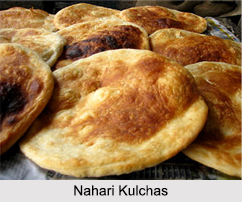 Awadhi Cuisine is known for its dum cooking style. Dishes like kebabs, kormas, biryani, kaliya, nahari-kulchas, zarda, sheermal, roomali rotis and warqi parathas are specialities of this cuisine. The richness of Awadhi cuisine lies in its ingredients like mutton, paneer and rich spices like cardamom and saffron. It is a cuisine native to the Awadh region in Northern India. The cooking patterns of Lucknow are similar to those of Central Asia, the Middle East, and Northern India with the cuisine comprising both vegetarian and non-vegetarian dishes. The Awadh region has been greatly influenced by Mughal cooking techniques, and the cuisine of Lucknow bears similarities to those of Central Asia, Kashmir, Punjab and Hyderabad. The city is also known for its Nawabi foods.
Awadhi Cuisine is known for its dum cooking style. Dishes like kebabs, kormas, biryani, kaliya, nahari-kulchas, zarda, sheermal, roomali rotis and warqi parathas are specialities of this cuisine. The richness of Awadhi cuisine lies in its ingredients like mutton, paneer and rich spices like cardamom and saffron. It is a cuisine native to the Awadh region in Northern India. The cooking patterns of Lucknow are similar to those of Central Asia, the Middle East, and Northern India with the cuisine comprising both vegetarian and non-vegetarian dishes. The Awadh region has been greatly influenced by Mughal cooking techniques, and the cuisine of Lucknow bears similarities to those of Central Asia, Kashmir, Punjab and Hyderabad. The city is also known for its Nawabi foods.Features of Awadhi Cuisine
Dastarkhwan is a carefully laid-out ceremonial dining spread that is customary in Awadh. The menu changes according to seasons. During winters rich food is consumed. Paye (trotters) is cooked overnight over a slow fire and the shorba (thick gravy) is eaten with naans. Turnips are also cooked overnight with meat koftas and served as an accompaniment during lunch. Birds like partridge and quail are consumed during winter as they are heat giving meats. Fish is relished in this time. River fish is preferred in Awadh. Peas are one of the used vegetable in this region.
The bawarchis (chefs) and rakabdars (gourmet cooks) of Awadh invented the dum style of cooking or the art of cooking over a slow fire, which has become synonymous with Lucknow today. Their spreads consisted of elaborate dishes such as kebabs, kormas, biryanis, kaliyas, nahari-kulchas, zarda, sheermal, rumali rotis, and warqi parathas. The richness of Awadh cuisine lies not only in the variety of cuisine but also in the ingredients used like mutton, paneer, and rich spices, which include cardamom and saffron.
Kebabs are an integral part of Awadhi food. Lucknow is proud of its Kebabs. There are several varieties of popular kebabs in Awadhi cuisinem namely Kakori Kebabs, Galawat ke Kebabs, Shami Kebabs, Boti Kebabs, Patili-ke-Kebabs, Ghutwa Kebabs and Seekh Kebabs are among the known varieties. The kebabs of Awadhi cuisine are distinct from the kebabs of Punjabi cuisine. Awadhi kebabs are grilled on a chula and sometimes in a skillet as opposed to grilling in a tandoor in Punjab. Awadhi kebabs are also called "chula" kebabs whereas the kebabs of Punjab are called "tandoori" kebabs.
Spices of Awadhi Cuisine
An Awadhi chef takes a long time to properly master how to cook dum-style, but it takes even longer to understand how to correctly use spices. There are easily fifty spices used regularly in the cuisine, but in total it is more like 150. The most common are Kebab Chini, Bay Leaf, Asafoetida or Hing, Liquorice, Black Peppercorn, Star Anise, Cinnamon, Clove, Cardamoms i.e. Badi Elaichi, Chotti Elaichi, Kala Jeera or Caraway Seeds, Cumin, Coriander, Chilies and Fenugreek.
Kebabs of Awadhi Cuisine The kebabs of Awadhi cuisine are distinct as they are grilled on a chula and sometimes in a skillet. The Seekh Kebab is one of the famous kebabs. Kakori kebab and shammi kebab are the most sought after kebabs. Other type of kebabs includes Galawat kebab, Pasanda Kebab, Boti kebab. There are even Vegetarian kebabs that include Dalcha Kebab, Kathal ke Kebab, Arbi ke Kebab, Rajma Galoti Kebab, Zamikand ke Kebab and so on.
For more on Awadhi recipes, check the link below: